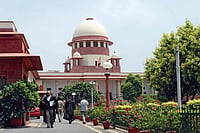The day Prime Minister Narendra Modi will inaugurate the new parliament building on May 28, will also see him installing a historic golden sceptre near the Speaker's seat, Union Home Minister Amit Shah announced today at a press conference. The sceptre called 'Sengol' was handed over to the country's first Prime Minister Jawaharlal Nehru to mark the transfer of power from British to Indians.
Union Home Minister Amit Shah was addressing a press conference on occasion of Prime Minister Narendra Modi completing nine years in power. “The new Parliament building has been constructed in record time and the PM will felicitate and honour 60,000 workers who built it. The new Parliament building shows PM Modi’s long-term vision,” said Amit Shah.
History of Sengol
Explaining the history and legacy of the sengol, Shah said that it was more or less forgotten after 1047. "Then, in 1971, a Tamil scholar mentioned it in a book. Our government mentioned it in 2021-22. The 96-year-old Tamil scholar, who was present in 1947, will also be there when it will be installed in the new Parliament building," Amit Shah said.
“A historical event is repeating itself. It is called Sengol in Tamil. It is historical with wealth. It is related to the tradition of the country. Sengol is a cultural heritage. This incident is related to August 14, 1947. This Sengol has played an important role in history. However, it did not come to our notice for so many years. Nehru accepted it from the Britishers on August 14, 1947,” said Shah at the conference.
The one who receives Sengol is expected to have a fair and just rule, he further said. It holds huge importance in Indian culture, especially Tamilian culture. “Sengol has been important from the time of the Chola dynast. This will be kept in the new Parliament," he said.
Further adding, he said that the transfer of power is not merely a handshake or signing a document and that it must remain connected with local traditions keeping in mind modern needs.
Nehru and Sengol
During the Chola period, the Sengol was of great importance during the coronation ceremonies of kings, and was symbolic of transfer of power from one ruler to the next.
According to reports, during the deliberations concerning the symbolic transfer of power from the British to Indian control, Viceroy Lord Mountbatten directed a query to Pandit Jawaharlal Nehru, the inaugural Prime Minister of independent India, regarding an appropriate ceremony that would signify the importance of the event.
Nehru turned to the esteemed statesman C. Rajagopalachari who proposed the ritual rooted in the ancient legacy of the Chola dynasty, where the transfer of power between kings was done after a high priest handed over a sceptre to a new king when he comes to power.
The Home Minister said that new Parliament building is an example of Prime Minister Narendra Modi's far-sightedness. He said the Prime Minister will honour 7,000 workers (shram yogis) on the inauguration. Shah said invitations for the inauguration of the new Parliament Building were sent to all political parties who were free to act according to their wisdom.
Responding to media queries, Mr Shah stressed that the Sengol should not be linked to politics. "We want the administration to run by the rule of law and this will always remind us of that," he said.
At least 19 Opposition parties, including the Congress, Aam Aadmi Party (AAP), Trinamool Congress, the Left, Rashtriya Janata Dal (RJD), Dravida Munnetra Kazhagam (DMK) and Uddhav Thackeray faction of the Shiv Sena on Wednesday said they will not be part of the event.
(With inputs from PTI)


























